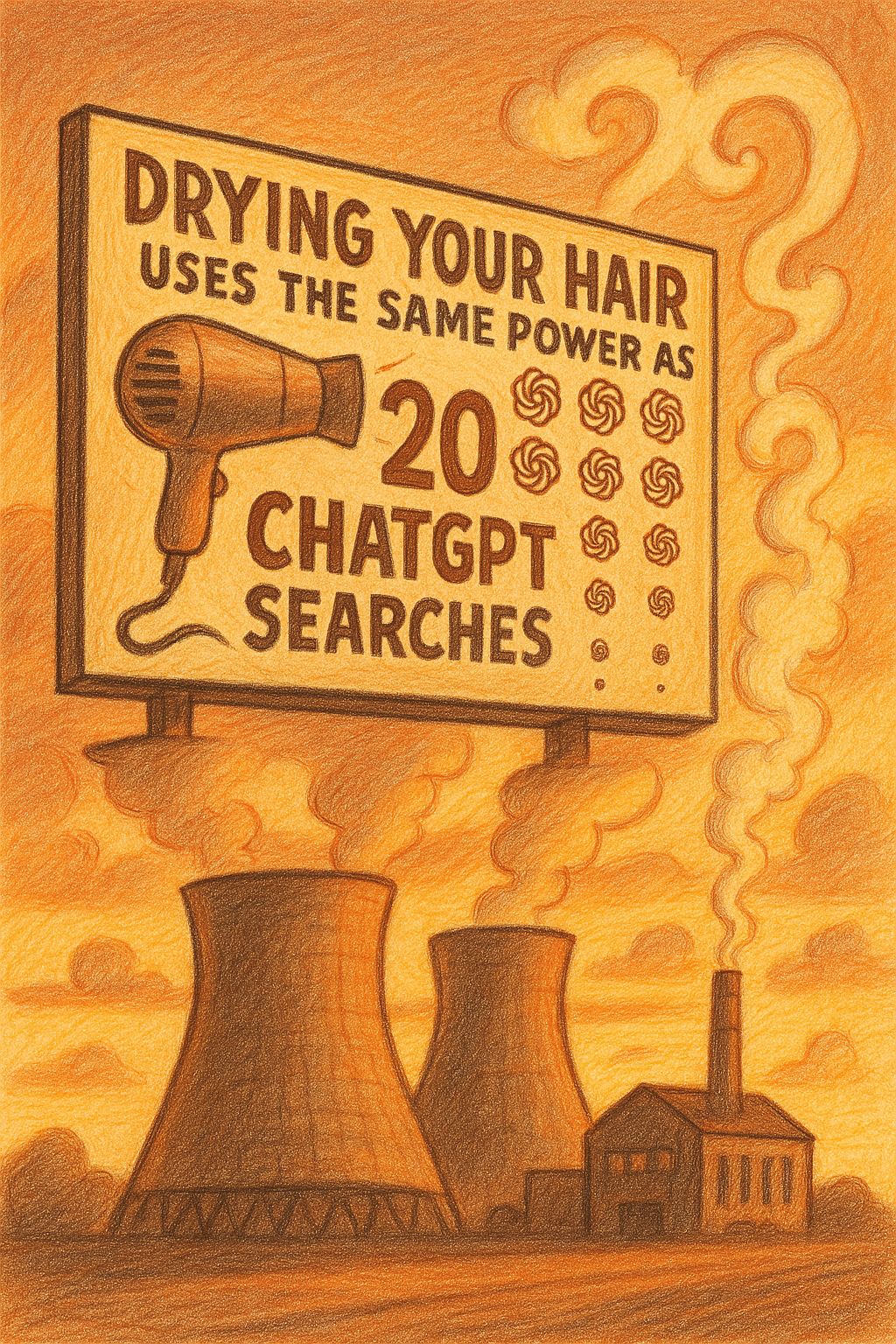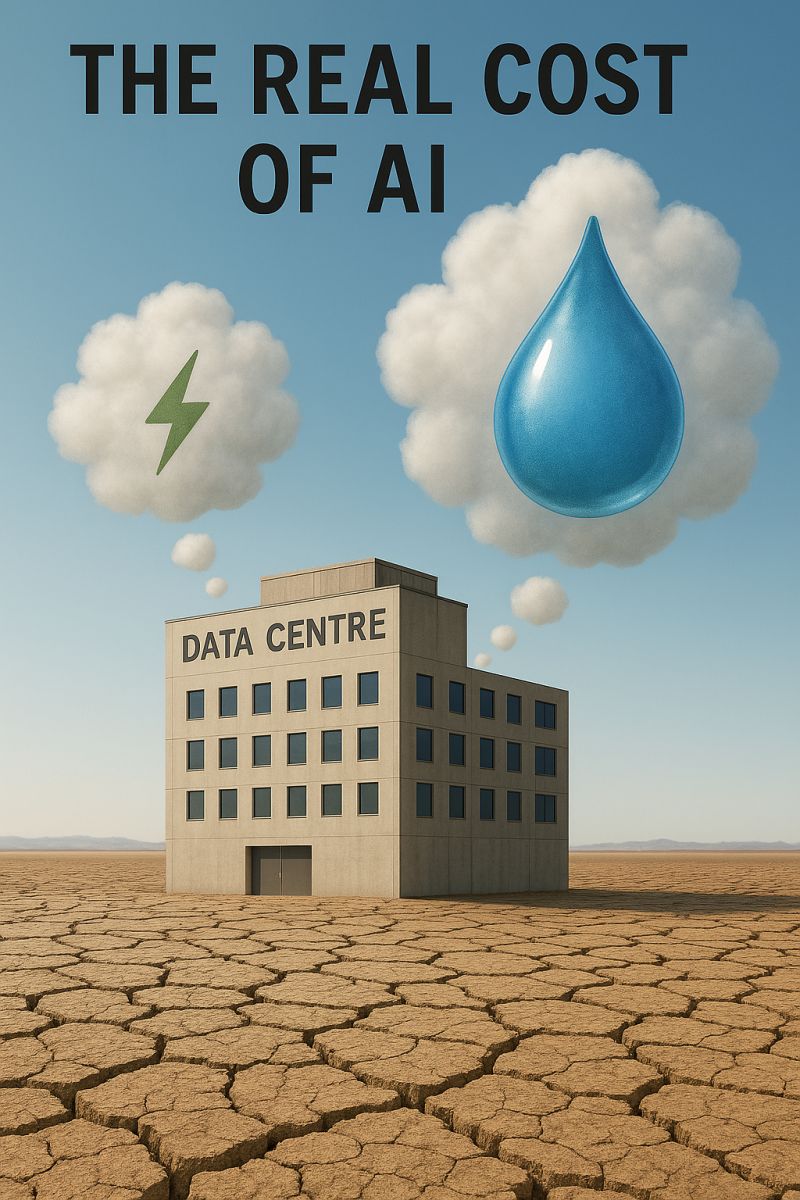
AI power usage generates significant controversy. Headlines paint it as an environmental catastrophe waiting to happen. The reality proves more nuanced and potentially more optimistic than these dire warnings suggest.
A ChatGPT query uses 10 times more energy than a Google search. This sounds alarming until one realises it equates to running your hairdryer for six seconds. The entire data centre industry, including all AI operations, accounts for just 1.5% of global electricity consumption.
Here is a rundown of the more pressing issues with AI power usage.
We can power AI with clean energy
Data centres power everything from email to streaming services to artificial intelligence. The total energy footprint of all data centres in the world remains remarkably modest at 1.5% of global electricity use. This figure includes all AI operations, from training to inference.
To put this in perspective, AI operations consume approximately 54 TWh annually, representing just 0.2% of global energy output. By comparison, Bitcoin mining alone uses 175 TWh, nearly triple AI usage, accounting for 0.6% of global energy. Unlike AI which drives technological progress and can help solve climate challenges, cryptocurrency mining provides questionable utility while consuming significant resources.
Another comparison: 1.5% roughly matches aviation industry emissions. However, aviation remains heavily dependent on fossil fuels, whereas data centres can transition to renewable energy sources. The tech industry has unprecedented opportunities to lead in sustainable operations.
Solving climate challenges requires abundant clean energy rather than solely focusing on reduced consumption. Human behaviour and technological progress make consumption reduction an unrealistic primary strategy. Instead, we must focus on transitioning to sustainable power sources and optimising resource usage.
We can use AI to solve climate challenges
AI serves as a powerful ally in our climate fight. Energy companies utilise artificial intelligence to optimise renewable energy systems, maximising their efficiency. AI can aid its own power transition to sustainable energy sources - no other use of power has this potential.
Other environmental applications already show promising results. Teams use AI systems to detect methane leaks from space, enabling rapid response to emissions. Agricultural researchers employ machine learning to breed heat-resistant crops, securing our food supply against climate change. Materials scientists harness AI to design new carbon capture compounds.
The real challenge is not power, but water
The environmental impact of AI extends beyond electricity consumption. Modern data centres require substantial water resources for cooling, and many new facilities are being constructed in regions already experiencing severe drought conditions. This presents a more immediate environmental challenge than power consumption.

Unlike electricity, which increasingly comes from renewable sources and benefits from rapidly advancing solar technology, fresh water remains a finite and unevenly distributed resource. The suggestion to reopen closed coal power plants for AI operations fundamentally misunderstands the challenge: power generation will become increasingly sustainable, but water scarcity cannot be solved through technological advancement alone.
The Path Forward
The solution lies not in abandoning AI development but in pursuing it responsibly through several key strategies:
Sustainable Power Sources
Our data centres must run on clean, renewable power sources. This transition requires strategic planning and investment but remains technically feasible. The rapid advancement of solar technology makes this increasingly achievable.
Strategic Water Management
Data centre locations need careful selection based on sustainable water availability. Regions facing drought conditions cannot support additional cooling requirements. This geographical constraint may shape the future distribution of AI infrastructure more than power availability.
Efficiency and Purpose
Continuous improvement in model efficiency reduces resource consumption while maintaining capabilities. This includes both training and inference optimisation. More importantly, we must prioritise AI applications that directly combat climate change. The technology possesses unique capabilities to address environmental challenges at scale.
AI power usage warrants attention but not panic. The technology presents both environmental challenges and opportunities. Our task involves maximising its potential for climate solutions while minimising its resource footprint. The real challenge lies not in power consumption, which renewable energy can increasingly address, but in responsible water usage and ensuring AI development serves meaningful environmental purposes.
I would like to thank Roisi Proven, Romilly Cocking, Tadas Tamošauskas, and Aimee Rivers for their thoughtful contributions to this discussion. Additional valuable insights came from Ajay Prabandham and Guillaume Roy.
More articles
Beyond the Demo: Building LLM Applications That Actually Ship
Every team building with LLMs faces the same crushing moment. The demo works perfectly. Stakeholders are impressed. Then you deploy to production and watch it fall apart. What worked flawlessly with test data breaks in ways you never imagined. The carefully crafted system that seemed so promising becomes a source of constant firefighting.
I recently spoke at Google Cloud about how to build LLM applications that actually make it to production. Not proof of concepts. Not investor demos. Real systems serving real customers every day.
Read more →Kill Your Prompts: Build Agents That Actually Work
Every technical team I talk to faces the same painful truth about AI agents. They build something that works brilliantly in their demo, showing it off to stakeholders who nod approvingly. Then they deploy it to production and watch it break in ways they never imagined. The carefully crafted prompts they spent weeks perfecting become a maintenance nightmare.
Recently I showed a (virtual) room full of technical leaders how to kill their prompts entirely. I do not mean improve them or optimise them. I mean kill them completely and build something better.
Read more →Master Prompt Stacking: The Secret to Making AI Code Like You Do
After months of fighting with inconsistent AI coding results, I discovered something that changed how I work with tools like Cursor. The problem was not my prompts. The problem was that I had no idea what else was being fed into the AI alongside my requests.
During a recent webinar, I walked through this discovery with a group of engineers who were facing the same frustrations. What we uncovered was both obvious and surprising: AI coding tools are far more complex than they appear on the surface.
Read more →The Huge List of AI Tools: What's Actually Worth Using in June 2025?
There are way too many AI tools out there now. Every week brings another dozen “revolutionary” AI products promising to transform how you work. It’s overwhelming trying to figure out what’s actually useful versus what’s just hype.
So I’ve put together this major comparison of all the major AI tools as of June 2025. No fluff, no marketing speak - just a straightforward look at what each tool actually does and who it’s best for. Whether you’re looking for coding help, content creation, or just want to chat with an AI, this should help you cut through the noise and find what you need.
Read more →Unlocking Real Leverage with AI Delegation
Starting to delegate to AI feels awkward. It is a lot like hiring your first contractor: you know there is leverage on the other side, but the first steps are messy and uncertain. The myth of the perfect plan holds many people back, but the reality is you just need to begin.
The payoff is real, but the start is always a little rough.
Here is how I do it.
Read more →